Research Proposal: Analyzing Diversity in Business Organizations
VerifiedAdded on 2022/09/17
|15
|3856
|29
Report
AI Summary
This research proposal examines the significance of diversity in contemporary organizations, focusing on its impact on productivity and innovation. It begins with an introduction and a research aim to explore how cultural diversity can improve productivity and innovativeness. The research question investigates the advantages and disadvantages of a diverse workforce. The literature review synthesizes ten scholarly articles, exploring topics such as diversity's effect on organizational performance, productivity, and the dynamics of diversity management, including challenges and how to overcome them. The methodology section outlines the research's purpose, data collection methods (questionnaire and interview surveys), sample design, and data analysis methods. A GANTT chart is included to visualize the research timeline. The proposal highlights the importance of diversity in the modern business world, emphasizing the need for a comprehensive understanding of its implications and strategies for effective management.
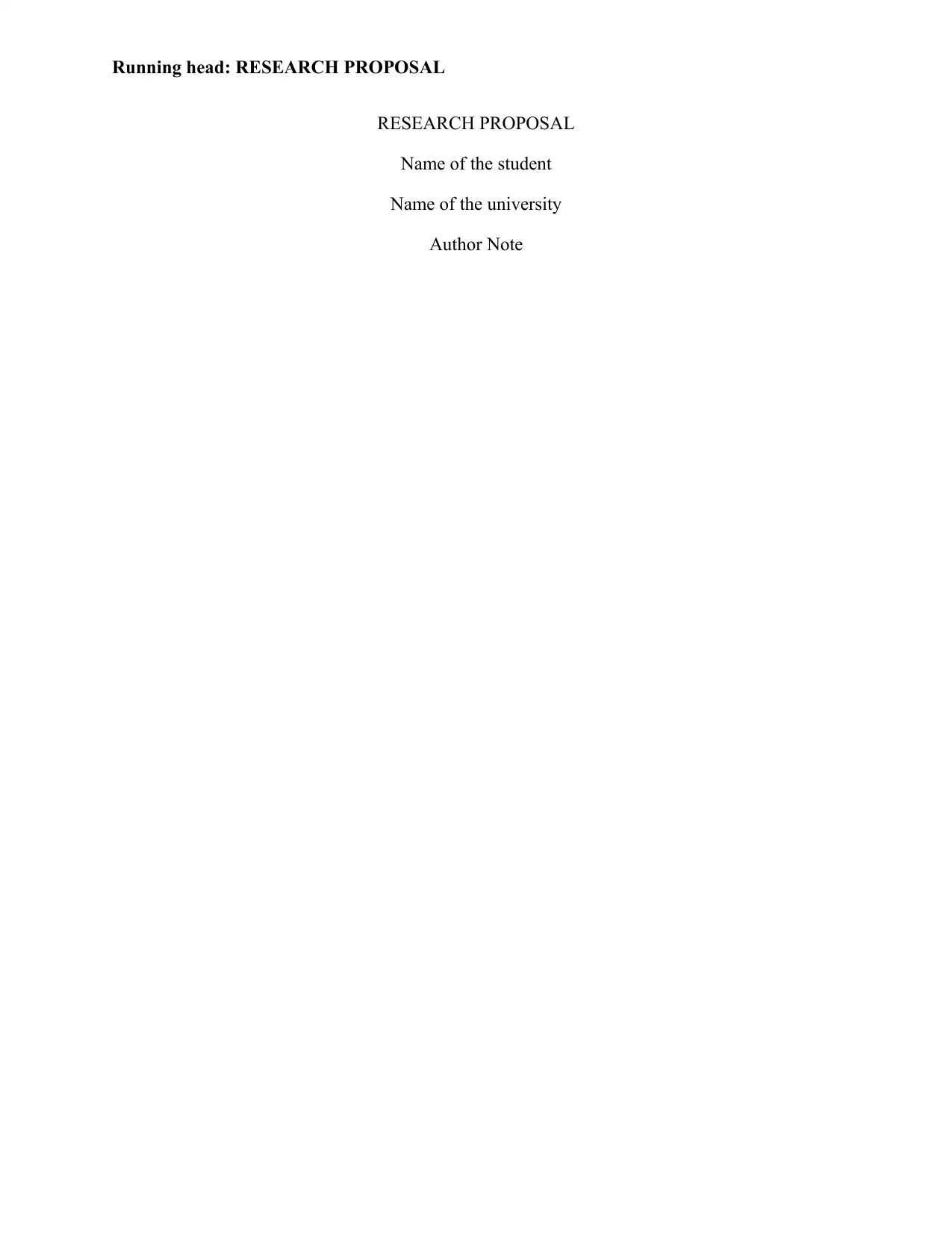
Running head: RESEARCH PROPOSAL
RESEARCH PROPOSAL
Name of the student
Name of the university
Author Note
RESEARCH PROPOSAL
Name of the student
Name of the university
Author Note
Paraphrase This Document
Need a fresh take? Get an instant paraphrase of this document with our AI Paraphraser
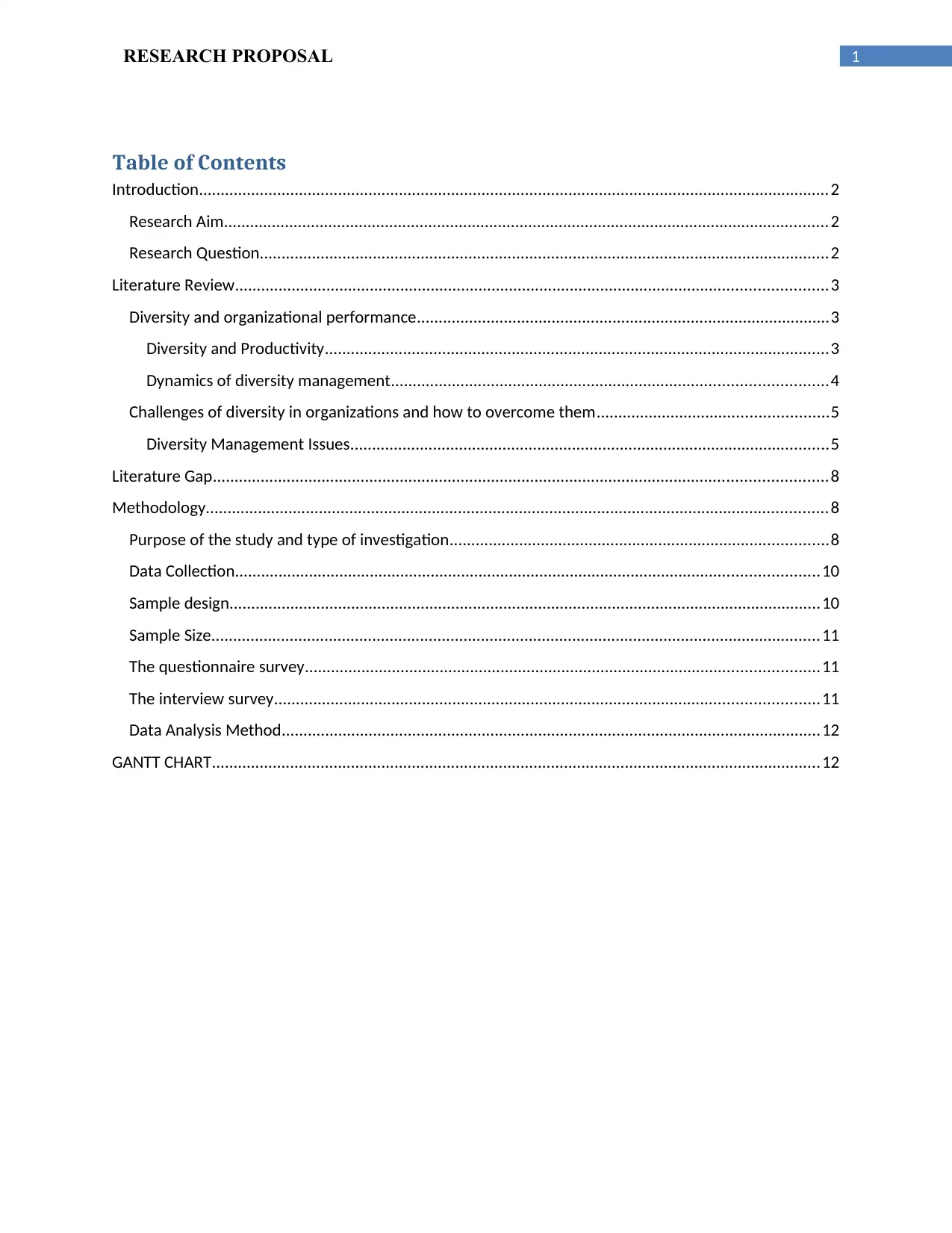
1RESEARCH PROPOSAL
Table of Contents
Introduction.................................................................................................................................................2
Research Aim...........................................................................................................................................2
Research Question...................................................................................................................................2
Literature Review........................................................................................................................................3
Diversity and organizational performance...............................................................................................3
Diversity and Productivity....................................................................................................................3
Dynamics of diversity management....................................................................................................4
Challenges of diversity in organizations and how to overcome them.....................................................5
Diversity Management Issues..............................................................................................................5
Literature Gap.............................................................................................................................................8
Methodology...............................................................................................................................................8
Purpose of the study and type of investigation.......................................................................................8
Data Collection......................................................................................................................................10
Sample design........................................................................................................................................10
Sample Size............................................................................................................................................11
The questionnaire survey......................................................................................................................11
The interview survey.............................................................................................................................11
Data Analysis Method............................................................................................................................12
GANTT CHART............................................................................................................................................12
Table of Contents
Introduction.................................................................................................................................................2
Research Aim...........................................................................................................................................2
Research Question...................................................................................................................................2
Literature Review........................................................................................................................................3
Diversity and organizational performance...............................................................................................3
Diversity and Productivity....................................................................................................................3
Dynamics of diversity management....................................................................................................4
Challenges of diversity in organizations and how to overcome them.....................................................5
Diversity Management Issues..............................................................................................................5
Literature Gap.............................................................................................................................................8
Methodology...............................................................................................................................................8
Purpose of the study and type of investigation.......................................................................................8
Data Collection......................................................................................................................................10
Sample design........................................................................................................................................10
Sample Size............................................................................................................................................11
The questionnaire survey......................................................................................................................11
The interview survey.............................................................................................................................11
Data Analysis Method............................................................................................................................12
GANTT CHART............................................................................................................................................12
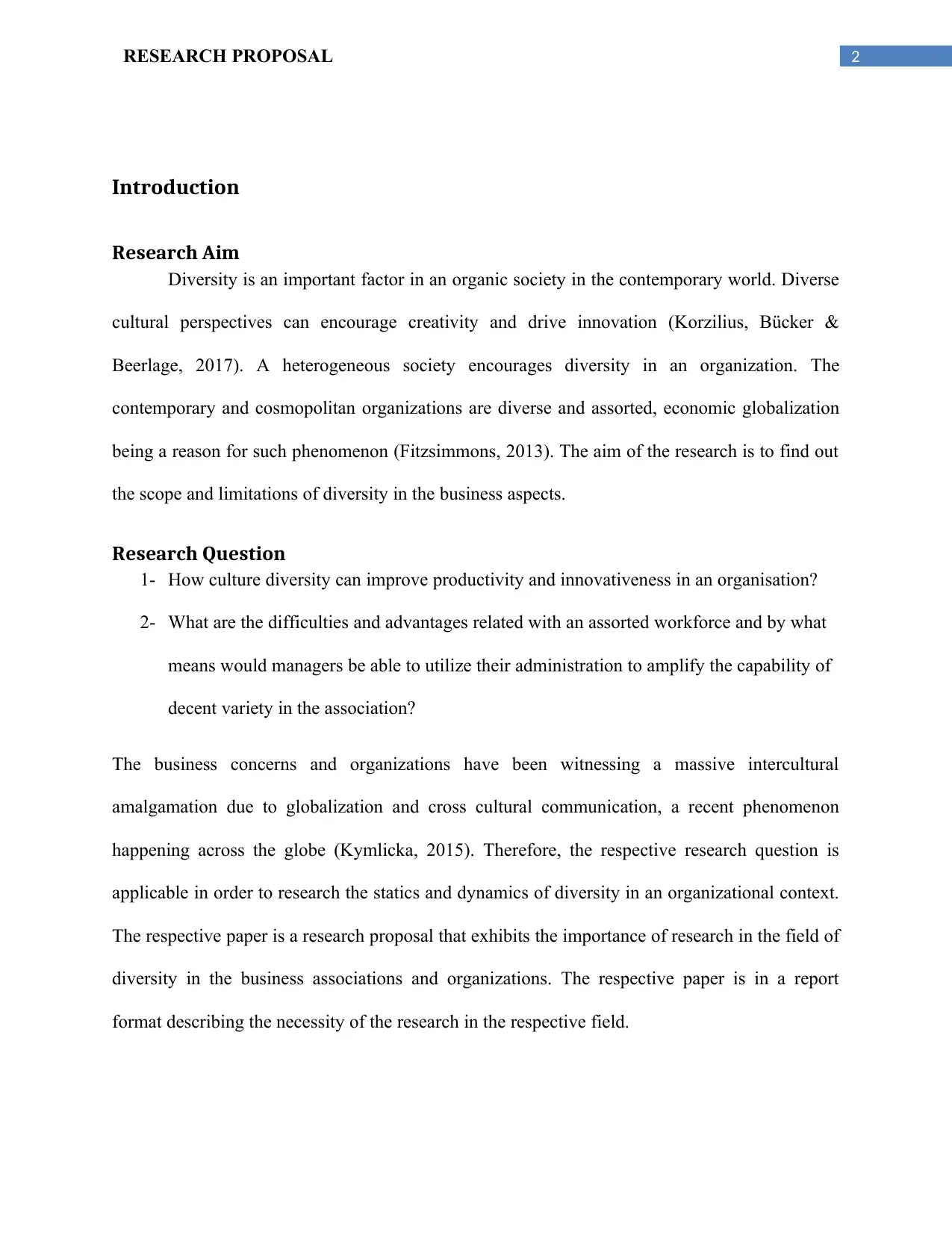
2RESEARCH PROPOSAL
Introduction
Research Aim
Diversity is an important factor in an organic society in the contemporary world. Diverse
cultural perspectives can encourage creativity and drive innovation (Korzilius, Bücker &
Beerlage, 2017). A heterogeneous society encourages diversity in an organization. The
contemporary and cosmopolitan organizations are diverse and assorted, economic globalization
being a reason for such phenomenon (Fitzsimmons, 2013). The aim of the research is to find out
the scope and limitations of diversity in the business aspects.
Research Question
1- How culture diversity can improve productivity and innovativeness in an organisation?
2- What are the difficulties and advantages related with an assorted workforce and by what
means would managers be able to utilize their administration to amplify the capability of
decent variety in the association?
The business concerns and organizations have been witnessing a massive intercultural
amalgamation due to globalization and cross cultural communication, a recent phenomenon
happening across the globe (Kymlicka, 2015). Therefore, the respective research question is
applicable in order to research the statics and dynamics of diversity in an organizational context.
The respective paper is a research proposal that exhibits the importance of research in the field of
diversity in the business associations and organizations. The respective paper is in a report
format describing the necessity of the research in the respective field.
Introduction
Research Aim
Diversity is an important factor in an organic society in the contemporary world. Diverse
cultural perspectives can encourage creativity and drive innovation (Korzilius, Bücker &
Beerlage, 2017). A heterogeneous society encourages diversity in an organization. The
contemporary and cosmopolitan organizations are diverse and assorted, economic globalization
being a reason for such phenomenon (Fitzsimmons, 2013). The aim of the research is to find out
the scope and limitations of diversity in the business aspects.
Research Question
1- How culture diversity can improve productivity and innovativeness in an organisation?
2- What are the difficulties and advantages related with an assorted workforce and by what
means would managers be able to utilize their administration to amplify the capability of
decent variety in the association?
The business concerns and organizations have been witnessing a massive intercultural
amalgamation due to globalization and cross cultural communication, a recent phenomenon
happening across the globe (Kymlicka, 2015). Therefore, the respective research question is
applicable in order to research the statics and dynamics of diversity in an organizational context.
The respective paper is a research proposal that exhibits the importance of research in the field of
diversity in the business associations and organizations. The respective paper is in a report
format describing the necessity of the research in the respective field.
⊘ This is a preview!⊘
Do you want full access?
Subscribe today to unlock all pages.

Trusted by 1+ million students worldwide
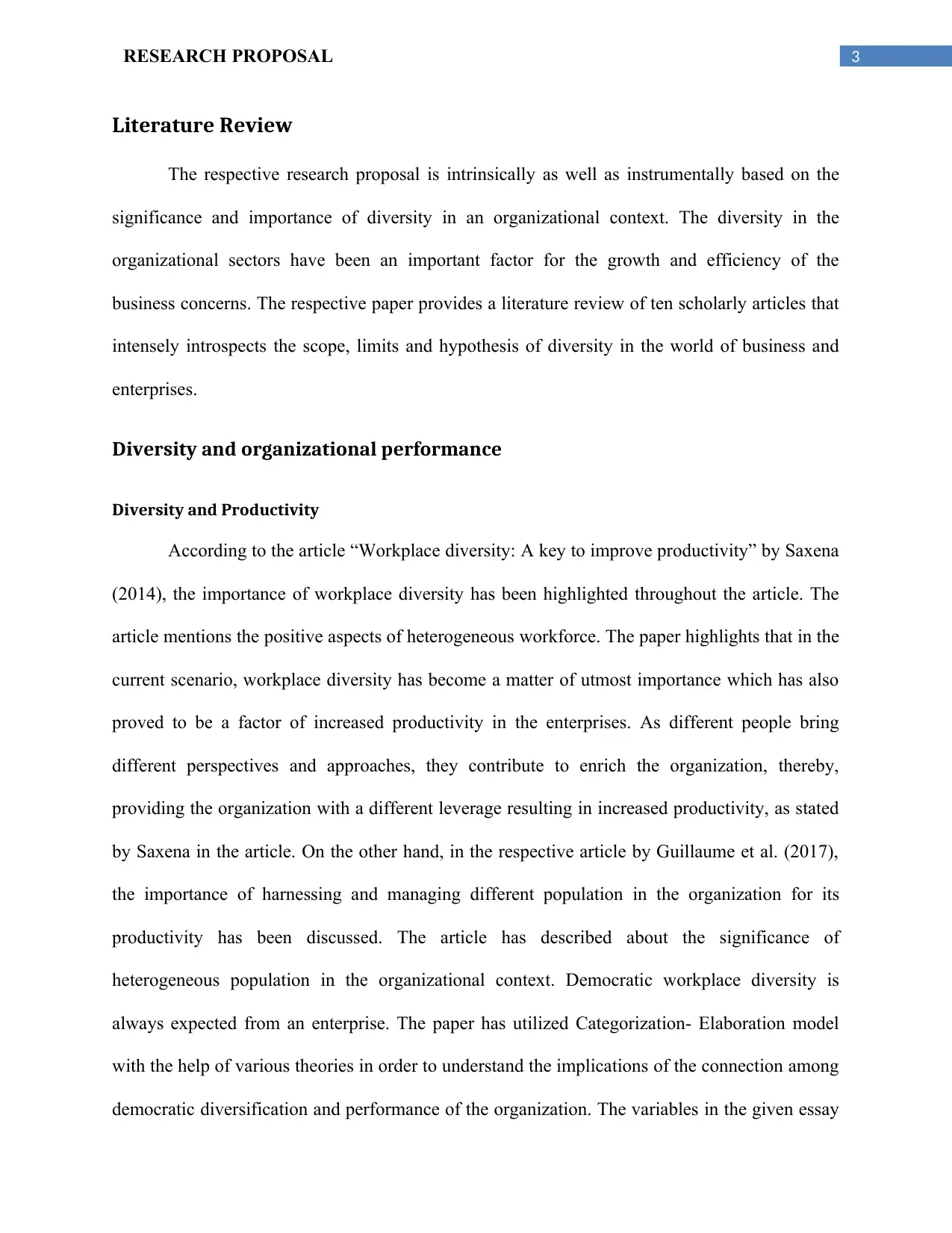
3RESEARCH PROPOSAL
Literature Review
The respective research proposal is intrinsically as well as instrumentally based on the
significance and importance of diversity in an organizational context. The diversity in the
organizational sectors have been an important factor for the growth and efficiency of the
business concerns. The respective paper provides a literature review of ten scholarly articles that
intensely introspects the scope, limits and hypothesis of diversity in the world of business and
enterprises.
Diversity and organizational performance
Diversity and Productivity
According to the article “Workplace diversity: A key to improve productivity” by Saxena
(2014), the importance of workplace diversity has been highlighted throughout the article. The
article mentions the positive aspects of heterogeneous workforce. The paper highlights that in the
current scenario, workplace diversity has become a matter of utmost importance which has also
proved to be a factor of increased productivity in the enterprises. As different people bring
different perspectives and approaches, they contribute to enrich the organization, thereby,
providing the organization with a different leverage resulting in increased productivity, as stated
by Saxena in the article. On the other hand, in the respective article by Guillaume et al. (2017),
the importance of harnessing and managing different population in the organization for its
productivity has been discussed. The article has described about the significance of
heterogeneous population in the organizational context. Democratic workplace diversity is
always expected from an enterprise. The paper has utilized Categorization- Elaboration model
with the help of various theories in order to understand the implications of the connection among
democratic diversification and performance of the organization. The variables in the given essay
Literature Review
The respective research proposal is intrinsically as well as instrumentally based on the
significance and importance of diversity in an organizational context. The diversity in the
organizational sectors have been an important factor for the growth and efficiency of the
business concerns. The respective paper provides a literature review of ten scholarly articles that
intensely introspects the scope, limits and hypothesis of diversity in the world of business and
enterprises.
Diversity and organizational performance
Diversity and Productivity
According to the article “Workplace diversity: A key to improve productivity” by Saxena
(2014), the importance of workplace diversity has been highlighted throughout the article. The
article mentions the positive aspects of heterogeneous workforce. The paper highlights that in the
current scenario, workplace diversity has become a matter of utmost importance which has also
proved to be a factor of increased productivity in the enterprises. As different people bring
different perspectives and approaches, they contribute to enrich the organization, thereby,
providing the organization with a different leverage resulting in increased productivity, as stated
by Saxena in the article. On the other hand, in the respective article by Guillaume et al. (2017),
the importance of harnessing and managing different population in the organization for its
productivity has been discussed. The article has described about the significance of
heterogeneous population in the organizational context. Democratic workplace diversity is
always expected from an enterprise. The paper has utilized Categorization- Elaboration model
with the help of various theories in order to understand the implications of the connection among
democratic diversification and performance of the organization. The variables in the given essay
Paraphrase This Document
Need a fresh take? Get an instant paraphrase of this document with our AI Paraphraser
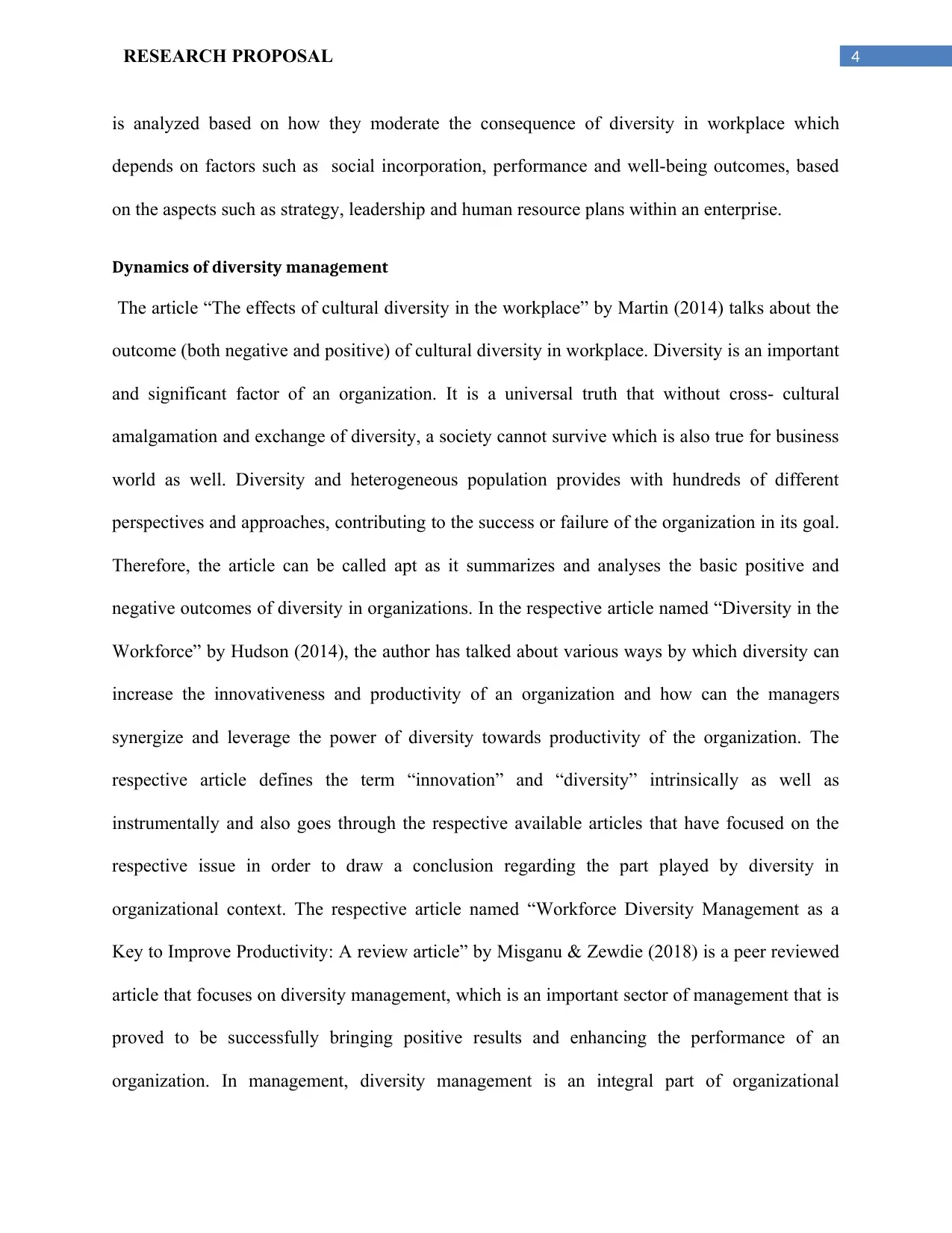
4RESEARCH PROPOSAL
is analyzed based on how they moderate the consequence of diversity in workplace which
depends on factors such as social incorporation, performance and well-being outcomes, based
on the aspects such as strategy, leadership and human resource plans within an enterprise.
Dynamics of diversity management
The article “The effects of cultural diversity in the workplace” by Martin (2014) talks about the
outcome (both negative and positive) of cultural diversity in workplace. Diversity is an important
and significant factor of an organization. It is a universal truth that without cross- cultural
amalgamation and exchange of diversity, a society cannot survive which is also true for business
world as well. Diversity and heterogeneous population provides with hundreds of different
perspectives and approaches, contributing to the success or failure of the organization in its goal.
Therefore, the article can be called apt as it summarizes and analyses the basic positive and
negative outcomes of diversity in organizations. In the respective article named “Diversity in the
Workforce” by Hudson (2014), the author has talked about various ways by which diversity can
increase the innovativeness and productivity of an organization and how can the managers
synergize and leverage the power of diversity towards productivity of the organization. The
respective article defines the term “innovation” and “diversity” intrinsically as well as
instrumentally and also goes through the respective available articles that have focused on the
respective issue in order to draw a conclusion regarding the part played by diversity in
organizational context. The respective article named “Workforce Diversity Management as a
Key to Improve Productivity: A review article” by Misganu & Zewdie (2018) is a peer reviewed
article that focuses on diversity management, which is an important sector of management that is
proved to be successfully bringing positive results and enhancing the performance of an
organization. In management, diversity management is an integral part of organizational
is analyzed based on how they moderate the consequence of diversity in workplace which
depends on factors such as social incorporation, performance and well-being outcomes, based
on the aspects such as strategy, leadership and human resource plans within an enterprise.
Dynamics of diversity management
The article “The effects of cultural diversity in the workplace” by Martin (2014) talks about the
outcome (both negative and positive) of cultural diversity in workplace. Diversity is an important
and significant factor of an organization. It is a universal truth that without cross- cultural
amalgamation and exchange of diversity, a society cannot survive which is also true for business
world as well. Diversity and heterogeneous population provides with hundreds of different
perspectives and approaches, contributing to the success or failure of the organization in its goal.
Therefore, the article can be called apt as it summarizes and analyses the basic positive and
negative outcomes of diversity in organizations. In the respective article named “Diversity in the
Workforce” by Hudson (2014), the author has talked about various ways by which diversity can
increase the innovativeness and productivity of an organization and how can the managers
synergize and leverage the power of diversity towards productivity of the organization. The
respective article defines the term “innovation” and “diversity” intrinsically as well as
instrumentally and also goes through the respective available articles that have focused on the
respective issue in order to draw a conclusion regarding the part played by diversity in
organizational context. The respective article named “Workforce Diversity Management as a
Key to Improve Productivity: A review article” by Misganu & Zewdie (2018) is a peer reviewed
article that focuses on diversity management, which is an important sector of management that is
proved to be successfully bringing positive results and enhancing the performance of an
organization. In management, diversity management is an integral part of organizational
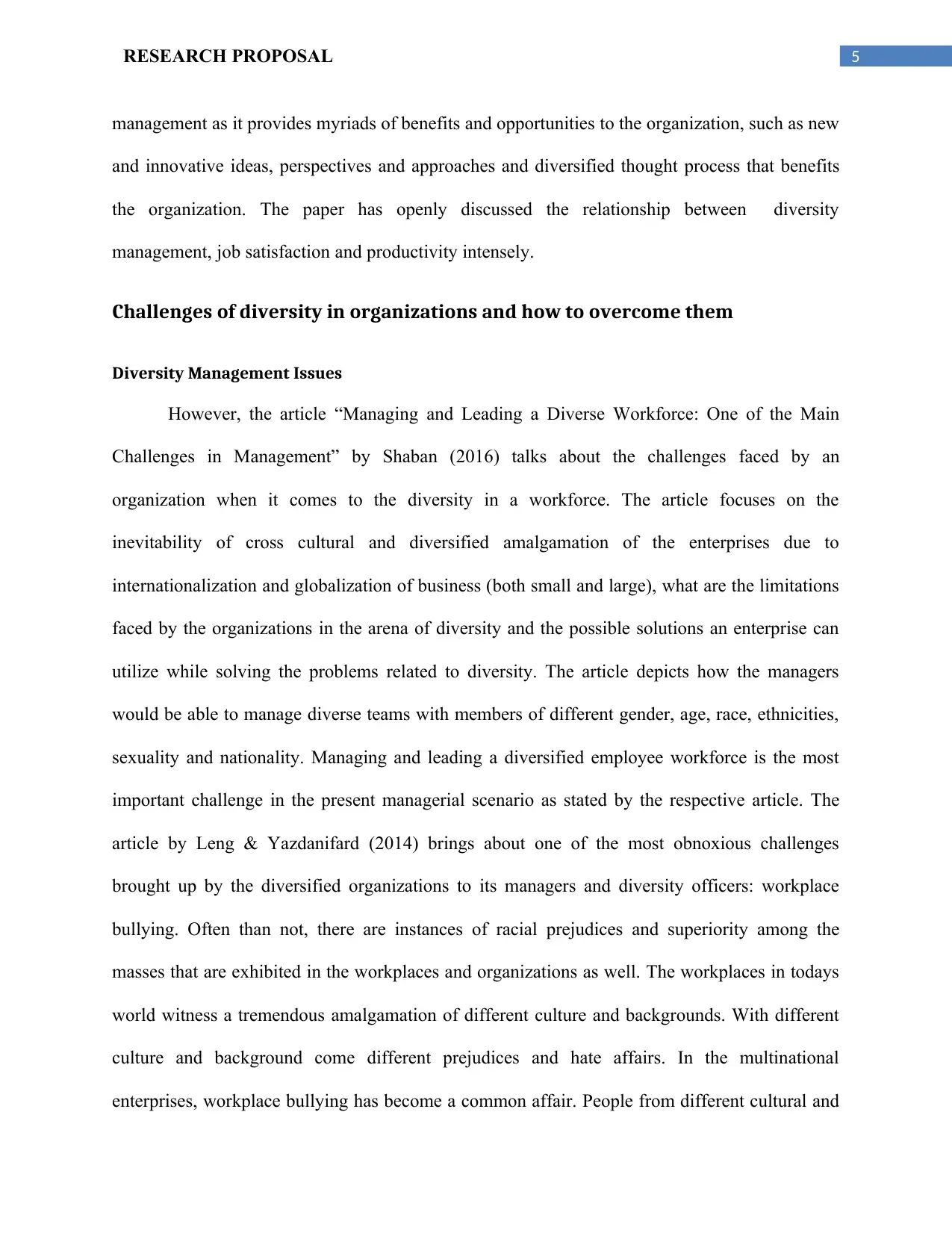
5RESEARCH PROPOSAL
management as it provides myriads of benefits and opportunities to the organization, such as new
and innovative ideas, perspectives and approaches and diversified thought process that benefits
the organization. The paper has openly discussed the relationship between diversity
management, job satisfaction and productivity intensely.
Challenges of diversity in organizations and how to overcome them
Diversity Management Issues
However, the article “Managing and Leading a Diverse Workforce: One of the Main
Challenges in Management” by Shaban (2016) talks about the challenges faced by an
organization when it comes to the diversity in a workforce. The article focuses on the
inevitability of cross cultural and diversified amalgamation of the enterprises due to
internationalization and globalization of business (both small and large), what are the limitations
faced by the organizations in the arena of diversity and the possible solutions an enterprise can
utilize while solving the problems related to diversity. The article depicts how the managers
would be able to manage diverse teams with members of different gender, age, race, ethnicities,
sexuality and nationality. Managing and leading a diversified employee workforce is the most
important challenge in the present managerial scenario as stated by the respective article. The
article by Leng & Yazdanifard (2014) brings about one of the most obnoxious challenges
brought up by the diversified organizations to its managers and diversity officers: workplace
bullying. Often than not, there are instances of racial prejudices and superiority among the
masses that are exhibited in the workplaces and organizations as well. The workplaces in todays
world witness a tremendous amalgamation of different culture and backgrounds. With different
culture and background come different prejudices and hate affairs. In the multinational
enterprises, workplace bullying has become a common affair. People from different cultural and
management as it provides myriads of benefits and opportunities to the organization, such as new
and innovative ideas, perspectives and approaches and diversified thought process that benefits
the organization. The paper has openly discussed the relationship between diversity
management, job satisfaction and productivity intensely.
Challenges of diversity in organizations and how to overcome them
Diversity Management Issues
However, the article “Managing and Leading a Diverse Workforce: One of the Main
Challenges in Management” by Shaban (2016) talks about the challenges faced by an
organization when it comes to the diversity in a workforce. The article focuses on the
inevitability of cross cultural and diversified amalgamation of the enterprises due to
internationalization and globalization of business (both small and large), what are the limitations
faced by the organizations in the arena of diversity and the possible solutions an enterprise can
utilize while solving the problems related to diversity. The article depicts how the managers
would be able to manage diverse teams with members of different gender, age, race, ethnicities,
sexuality and nationality. Managing and leading a diversified employee workforce is the most
important challenge in the present managerial scenario as stated by the respective article. The
article by Leng & Yazdanifard (2014) brings about one of the most obnoxious challenges
brought up by the diversified organizations to its managers and diversity officers: workplace
bullying. Often than not, there are instances of racial prejudices and superiority among the
masses that are exhibited in the workplaces and organizations as well. The workplaces in todays
world witness a tremendous amalgamation of different culture and backgrounds. With different
culture and background come different prejudices and hate affairs. In the multinational
enterprises, workplace bullying has become a common affair. People from different cultural and
⊘ This is a preview!⊘
Do you want full access?
Subscribe today to unlock all pages.

Trusted by 1+ million students worldwide
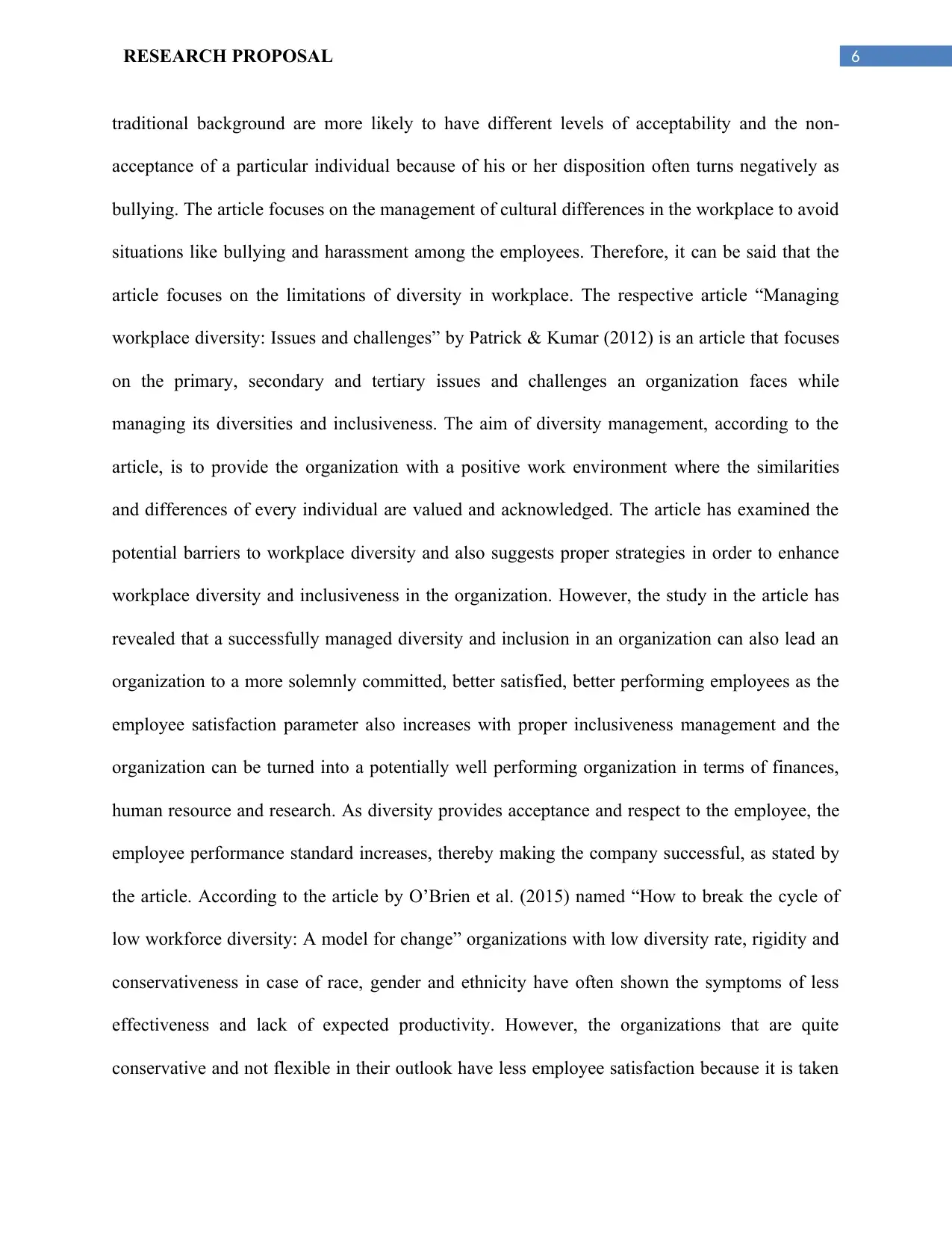
6RESEARCH PROPOSAL
traditional background are more likely to have different levels of acceptability and the non-
acceptance of a particular individual because of his or her disposition often turns negatively as
bullying. The article focuses on the management of cultural differences in the workplace to avoid
situations like bullying and harassment among the employees. Therefore, it can be said that the
article focuses on the limitations of diversity in workplace. The respective article “Managing
workplace diversity: Issues and challenges” by Patrick & Kumar (2012) is an article that focuses
on the primary, secondary and tertiary issues and challenges an organization faces while
managing its diversities and inclusiveness. The aim of diversity management, according to the
article, is to provide the organization with a positive work environment where the similarities
and differences of every individual are valued and acknowledged. The article has examined the
potential barriers to workplace diversity and also suggests proper strategies in order to enhance
workplace diversity and inclusiveness in the organization. However, the study in the article has
revealed that a successfully managed diversity and inclusion in an organization can also lead an
organization to a more solemnly committed, better satisfied, better performing employees as the
employee satisfaction parameter also increases with proper inclusiveness management and the
organization can be turned into a potentially well performing organization in terms of finances,
human resource and research. As diversity provides acceptance and respect to the employee, the
employee performance standard increases, thereby making the company successful, as stated by
the article. According to the article by O’Brien et al. (2015) named “How to break the cycle of
low workforce diversity: A model for change” organizations with low diversity rate, rigidity and
conservativeness in case of race, gender and ethnicity have often shown the symptoms of less
effectiveness and lack of expected productivity. However, the organizations that are quite
conservative and not flexible in their outlook have less employee satisfaction because it is taken
traditional background are more likely to have different levels of acceptability and the non-
acceptance of a particular individual because of his or her disposition often turns negatively as
bullying. The article focuses on the management of cultural differences in the workplace to avoid
situations like bullying and harassment among the employees. Therefore, it can be said that the
article focuses on the limitations of diversity in workplace. The respective article “Managing
workplace diversity: Issues and challenges” by Patrick & Kumar (2012) is an article that focuses
on the primary, secondary and tertiary issues and challenges an organization faces while
managing its diversities and inclusiveness. The aim of diversity management, according to the
article, is to provide the organization with a positive work environment where the similarities
and differences of every individual are valued and acknowledged. The article has examined the
potential barriers to workplace diversity and also suggests proper strategies in order to enhance
workplace diversity and inclusiveness in the organization. However, the study in the article has
revealed that a successfully managed diversity and inclusion in an organization can also lead an
organization to a more solemnly committed, better satisfied, better performing employees as the
employee satisfaction parameter also increases with proper inclusiveness management and the
organization can be turned into a potentially well performing organization in terms of finances,
human resource and research. As diversity provides acceptance and respect to the employee, the
employee performance standard increases, thereby making the company successful, as stated by
the article. According to the article by O’Brien et al. (2015) named “How to break the cycle of
low workforce diversity: A model for change” organizations with low diversity rate, rigidity and
conservativeness in case of race, gender and ethnicity have often shown the symptoms of less
effectiveness and lack of expected productivity. However, the organizations that are quite
conservative and not flexible in their outlook have less employee satisfaction because it is taken
Paraphrase This Document
Need a fresh take? Get an instant paraphrase of this document with our AI Paraphraser
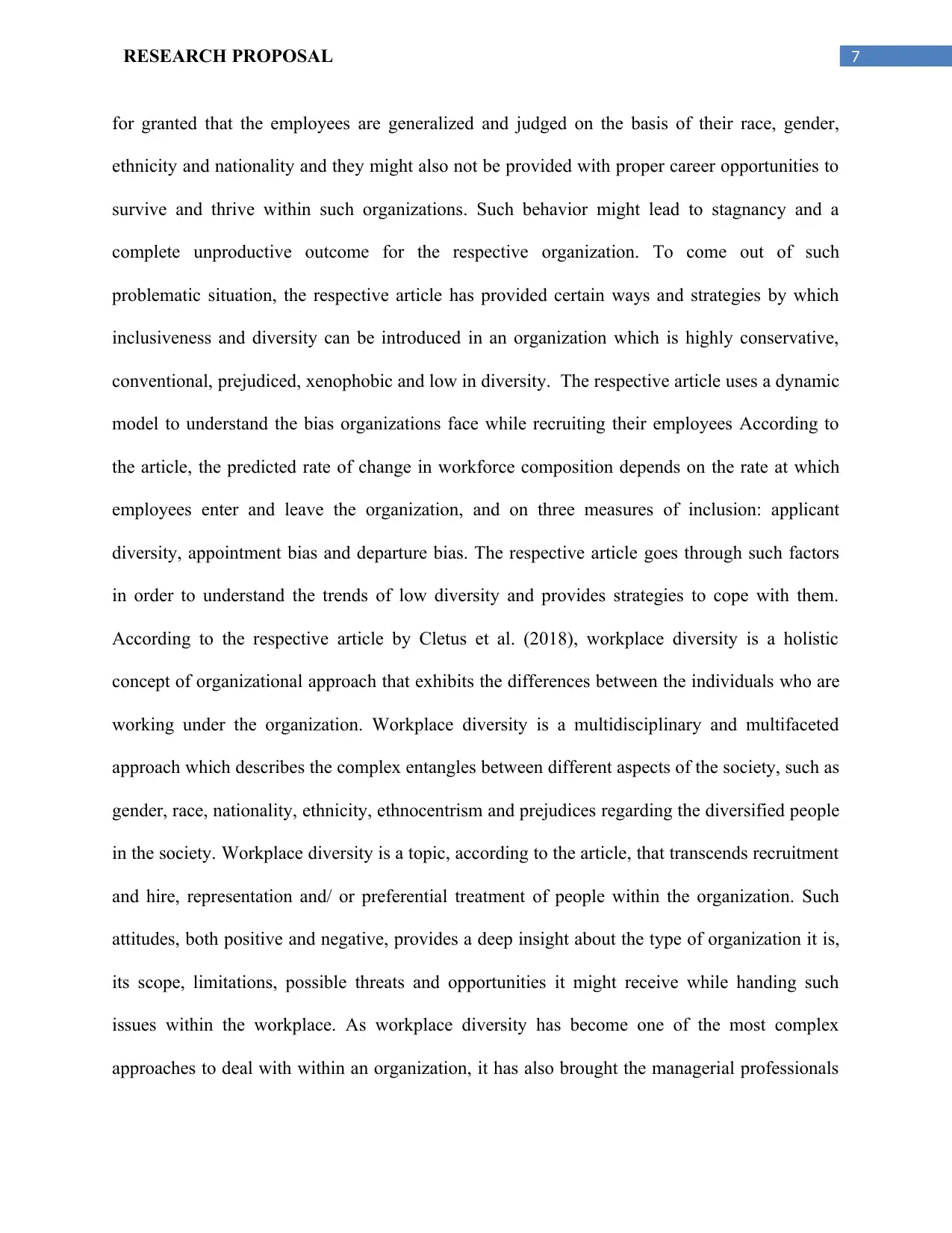
7RESEARCH PROPOSAL
for granted that the employees are generalized and judged on the basis of their race, gender,
ethnicity and nationality and they might also not be provided with proper career opportunities to
survive and thrive within such organizations. Such behavior might lead to stagnancy and a
complete unproductive outcome for the respective organization. To come out of such
problematic situation, the respective article has provided certain ways and strategies by which
inclusiveness and diversity can be introduced in an organization which is highly conservative,
conventional, prejudiced, xenophobic and low in diversity. The respective article uses a dynamic
model to understand the bias organizations face while recruiting their employees According to
the article, the predicted rate of change in workforce composition depends on the rate at which
employees enter and leave the organization, and on three measures of inclusion: applicant
diversity, appointment bias and departure bias. The respective article goes through such factors
in order to understand the trends of low diversity and provides strategies to cope with them.
According to the respective article by Cletus et al. (2018), workplace diversity is a holistic
concept of organizational approach that exhibits the differences between the individuals who are
working under the organization. Workplace diversity is a multidisciplinary and multifaceted
approach which describes the complex entangles between different aspects of the society, such as
gender, race, nationality, ethnicity, ethnocentrism and prejudices regarding the diversified people
in the society. Workplace diversity is a topic, according to the article, that transcends recruitment
and hire, representation and/ or preferential treatment of people within the organization. Such
attitudes, both positive and negative, provides a deep insight about the type of organization it is,
its scope, limitations, possible threats and opportunities it might receive while handing such
issues within the workplace. As workplace diversity has become one of the most complex
approaches to deal with within an organization, it has also brought the managerial professionals
for granted that the employees are generalized and judged on the basis of their race, gender,
ethnicity and nationality and they might also not be provided with proper career opportunities to
survive and thrive within such organizations. Such behavior might lead to stagnancy and a
complete unproductive outcome for the respective organization. To come out of such
problematic situation, the respective article has provided certain ways and strategies by which
inclusiveness and diversity can be introduced in an organization which is highly conservative,
conventional, prejudiced, xenophobic and low in diversity. The respective article uses a dynamic
model to understand the bias organizations face while recruiting their employees According to
the article, the predicted rate of change in workforce composition depends on the rate at which
employees enter and leave the organization, and on three measures of inclusion: applicant
diversity, appointment bias and departure bias. The respective article goes through such factors
in order to understand the trends of low diversity and provides strategies to cope with them.
According to the respective article by Cletus et al. (2018), workplace diversity is a holistic
concept of organizational approach that exhibits the differences between the individuals who are
working under the organization. Workplace diversity is a multidisciplinary and multifaceted
approach which describes the complex entangles between different aspects of the society, such as
gender, race, nationality, ethnicity, ethnocentrism and prejudices regarding the diversified people
in the society. Workplace diversity is a topic, according to the article, that transcends recruitment
and hire, representation and/ or preferential treatment of people within the organization. Such
attitudes, both positive and negative, provides a deep insight about the type of organization it is,
its scope, limitations, possible threats and opportunities it might receive while handing such
issues within the workplace. As workplace diversity has become one of the most complex
approaches to deal with within an organization, it has also brought the managerial professionals
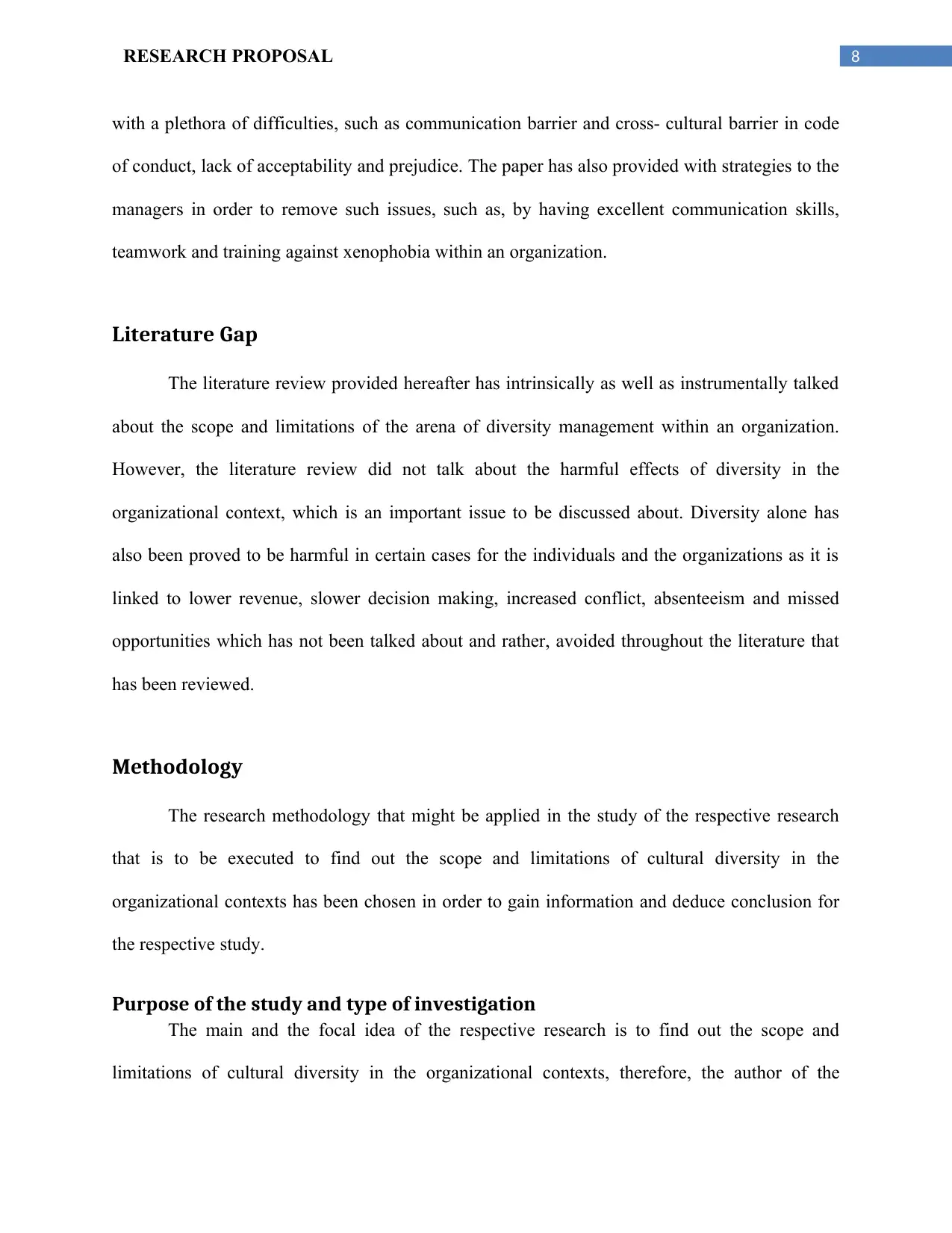
8RESEARCH PROPOSAL
with a plethora of difficulties, such as communication barrier and cross- cultural barrier in code
of conduct, lack of acceptability and prejudice. The paper has also provided with strategies to the
managers in order to remove such issues, such as, by having excellent communication skills,
teamwork and training against xenophobia within an organization.
Literature Gap
The literature review provided hereafter has intrinsically as well as instrumentally talked
about the scope and limitations of the arena of diversity management within an organization.
However, the literature review did not talk about the harmful effects of diversity in the
organizational context, which is an important issue to be discussed about. Diversity alone has
also been proved to be harmful in certain cases for the individuals and the organizations as it is
linked to lower revenue, slower decision making, increased conflict, absenteeism and missed
opportunities which has not been talked about and rather, avoided throughout the literature that
has been reviewed.
Methodology
The research methodology that might be applied in the study of the respective research
that is to be executed to find out the scope and limitations of cultural diversity in the
organizational contexts has been chosen in order to gain information and deduce conclusion for
the respective study.
Purpose of the study and type of investigation
The main and the focal idea of the respective research is to find out the scope and
limitations of cultural diversity in the organizational contexts, therefore, the author of the
with a plethora of difficulties, such as communication barrier and cross- cultural barrier in code
of conduct, lack of acceptability and prejudice. The paper has also provided with strategies to the
managers in order to remove such issues, such as, by having excellent communication skills,
teamwork and training against xenophobia within an organization.
Literature Gap
The literature review provided hereafter has intrinsically as well as instrumentally talked
about the scope and limitations of the arena of diversity management within an organization.
However, the literature review did not talk about the harmful effects of diversity in the
organizational context, which is an important issue to be discussed about. Diversity alone has
also been proved to be harmful in certain cases for the individuals and the organizations as it is
linked to lower revenue, slower decision making, increased conflict, absenteeism and missed
opportunities which has not been talked about and rather, avoided throughout the literature that
has been reviewed.
Methodology
The research methodology that might be applied in the study of the respective research
that is to be executed to find out the scope and limitations of cultural diversity in the
organizational contexts has been chosen in order to gain information and deduce conclusion for
the respective study.
Purpose of the study and type of investigation
The main and the focal idea of the respective research is to find out the scope and
limitations of cultural diversity in the organizational contexts, therefore, the author of the
⊘ This is a preview!⊘
Do you want full access?
Subscribe today to unlock all pages.

Trusted by 1+ million students worldwide
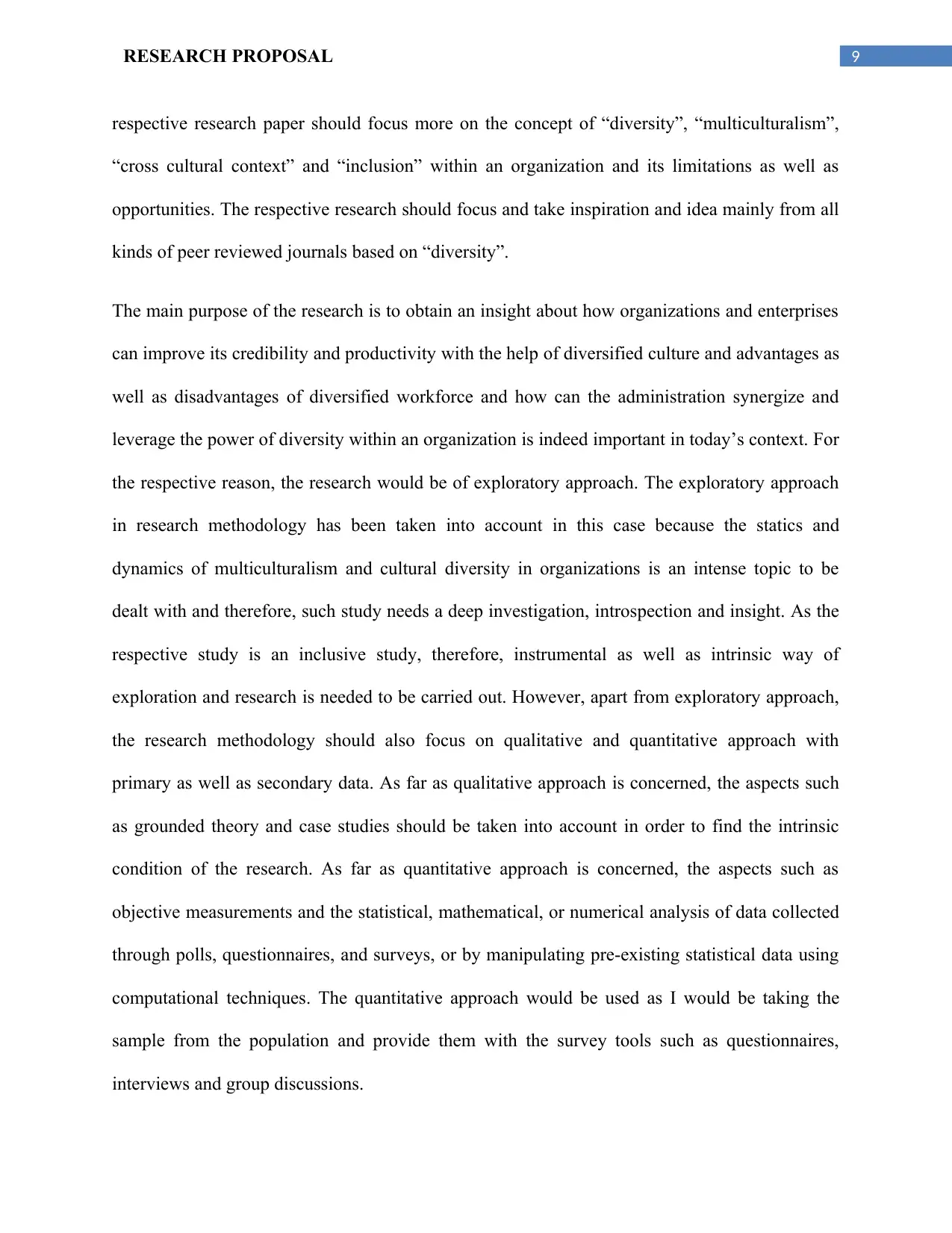
9RESEARCH PROPOSAL
respective research paper should focus more on the concept of “diversity”, “multiculturalism”,
“cross cultural context” and “inclusion” within an organization and its limitations as well as
opportunities. The respective research should focus and take inspiration and idea mainly from all
kinds of peer reviewed journals based on “diversity”.
The main purpose of the research is to obtain an insight about how organizations and enterprises
can improve its credibility and productivity with the help of diversified culture and advantages as
well as disadvantages of diversified workforce and how can the administration synergize and
leverage the power of diversity within an organization is indeed important in today’s context. For
the respective reason, the research would be of exploratory approach. The exploratory approach
in research methodology has been taken into account in this case because the statics and
dynamics of multiculturalism and cultural diversity in organizations is an intense topic to be
dealt with and therefore, such study needs a deep investigation, introspection and insight. As the
respective study is an inclusive study, therefore, instrumental as well as intrinsic way of
exploration and research is needed to be carried out. However, apart from exploratory approach,
the research methodology should also focus on qualitative and quantitative approach with
primary as well as secondary data. As far as qualitative approach is concerned, the aspects such
as grounded theory and case studies should be taken into account in order to find the intrinsic
condition of the research. As far as quantitative approach is concerned, the aspects such as
objective measurements and the statistical, mathematical, or numerical analysis of data collected
through polls, questionnaires, and surveys, or by manipulating pre-existing statistical data using
computational techniques. The quantitative approach would be used as I would be taking the
sample from the population and provide them with the survey tools such as questionnaires,
interviews and group discussions.
respective research paper should focus more on the concept of “diversity”, “multiculturalism”,
“cross cultural context” and “inclusion” within an organization and its limitations as well as
opportunities. The respective research should focus and take inspiration and idea mainly from all
kinds of peer reviewed journals based on “diversity”.
The main purpose of the research is to obtain an insight about how organizations and enterprises
can improve its credibility and productivity with the help of diversified culture and advantages as
well as disadvantages of diversified workforce and how can the administration synergize and
leverage the power of diversity within an organization is indeed important in today’s context. For
the respective reason, the research would be of exploratory approach. The exploratory approach
in research methodology has been taken into account in this case because the statics and
dynamics of multiculturalism and cultural diversity in organizations is an intense topic to be
dealt with and therefore, such study needs a deep investigation, introspection and insight. As the
respective study is an inclusive study, therefore, instrumental as well as intrinsic way of
exploration and research is needed to be carried out. However, apart from exploratory approach,
the research methodology should also focus on qualitative and quantitative approach with
primary as well as secondary data. As far as qualitative approach is concerned, the aspects such
as grounded theory and case studies should be taken into account in order to find the intrinsic
condition of the research. As far as quantitative approach is concerned, the aspects such as
objective measurements and the statistical, mathematical, or numerical analysis of data collected
through polls, questionnaires, and surveys, or by manipulating pre-existing statistical data using
computational techniques. The quantitative approach would be used as I would be taking the
sample from the population and provide them with the survey tools such as questionnaires,
interviews and group discussions.
Paraphrase This Document
Need a fresh take? Get an instant paraphrase of this document with our AI Paraphraser
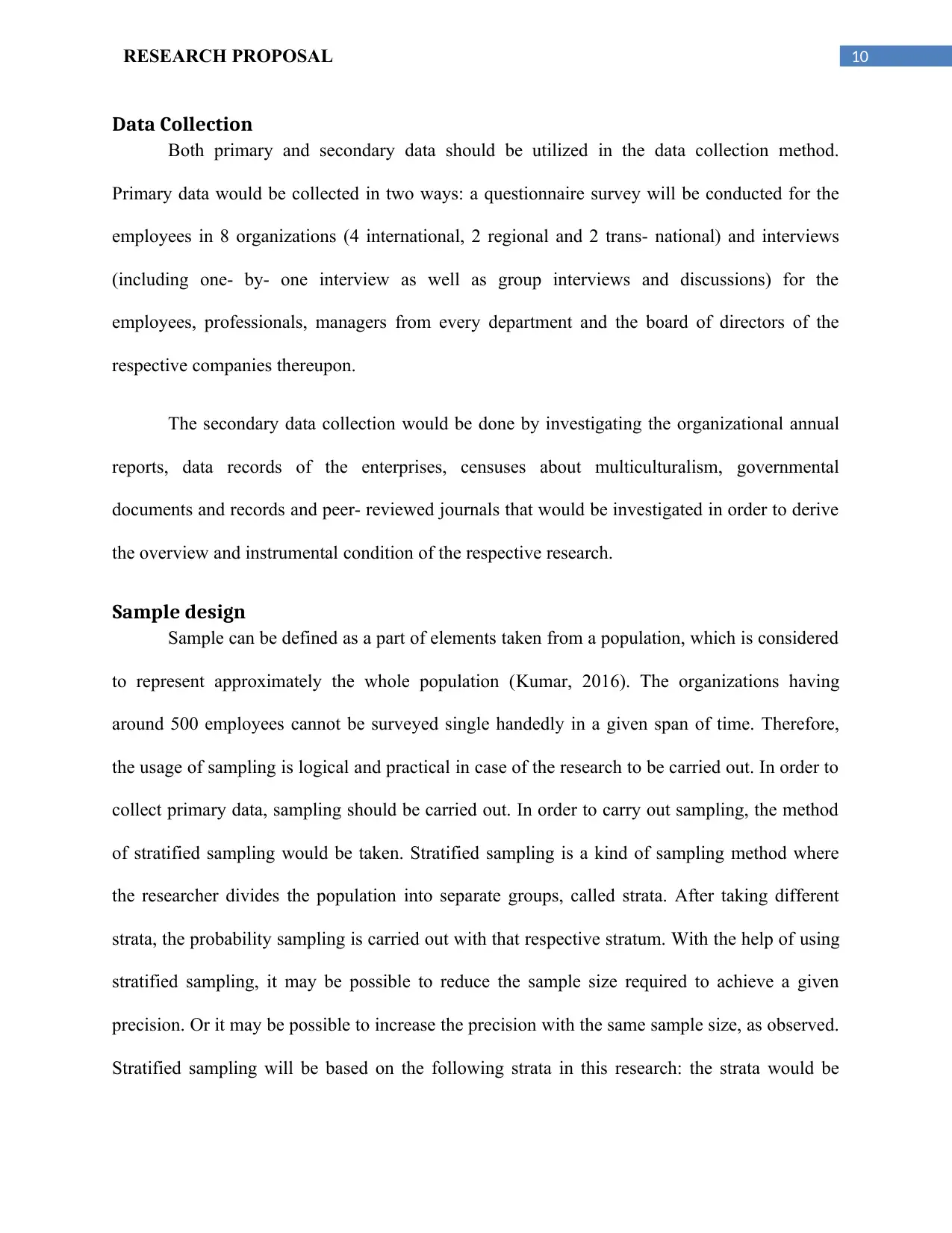
10RESEARCH PROPOSAL
Data Collection
Both primary and secondary data should be utilized in the data collection method.
Primary data would be collected in two ways: a questionnaire survey will be conducted for the
employees in 8 organizations (4 international, 2 regional and 2 trans- national) and interviews
(including one- by- one interview as well as group interviews and discussions) for the
employees, professionals, managers from every department and the board of directors of the
respective companies thereupon.
The secondary data collection would be done by investigating the organizational annual
reports, data records of the enterprises, censuses about multiculturalism, governmental
documents and records and peer- reviewed journals that would be investigated in order to derive
the overview and instrumental condition of the respective research.
Sample design
Sample can be defined as a part of elements taken from a population, which is considered
to represent approximately the whole population (Kumar, 2016). The organizations having
around 500 employees cannot be surveyed single handedly in a given span of time. Therefore,
the usage of sampling is logical and practical in case of the research to be carried out. In order to
collect primary data, sampling should be carried out. In order to carry out sampling, the method
of stratified sampling would be taken. Stratified sampling is a kind of sampling method where
the researcher divides the population into separate groups, called strata. After taking different
strata, the probability sampling is carried out with that respective stratum. With the help of using
stratified sampling, it may be possible to reduce the sample size required to achieve a given
precision. Or it may be possible to increase the precision with the same sample size, as observed.
Stratified sampling will be based on the following strata in this research: the strata would be
Data Collection
Both primary and secondary data should be utilized in the data collection method.
Primary data would be collected in two ways: a questionnaire survey will be conducted for the
employees in 8 organizations (4 international, 2 regional and 2 trans- national) and interviews
(including one- by- one interview as well as group interviews and discussions) for the
employees, professionals, managers from every department and the board of directors of the
respective companies thereupon.
The secondary data collection would be done by investigating the organizational annual
reports, data records of the enterprises, censuses about multiculturalism, governmental
documents and records and peer- reviewed journals that would be investigated in order to derive
the overview and instrumental condition of the respective research.
Sample design
Sample can be defined as a part of elements taken from a population, which is considered
to represent approximately the whole population (Kumar, 2016). The organizations having
around 500 employees cannot be surveyed single handedly in a given span of time. Therefore,
the usage of sampling is logical and practical in case of the research to be carried out. In order to
collect primary data, sampling should be carried out. In order to carry out sampling, the method
of stratified sampling would be taken. Stratified sampling is a kind of sampling method where
the researcher divides the population into separate groups, called strata. After taking different
strata, the probability sampling is carried out with that respective stratum. With the help of using
stratified sampling, it may be possible to reduce the sample size required to achieve a given
precision. Or it may be possible to increase the precision with the same sample size, as observed.
Stratified sampling will be based on the following strata in this research: the strata would be
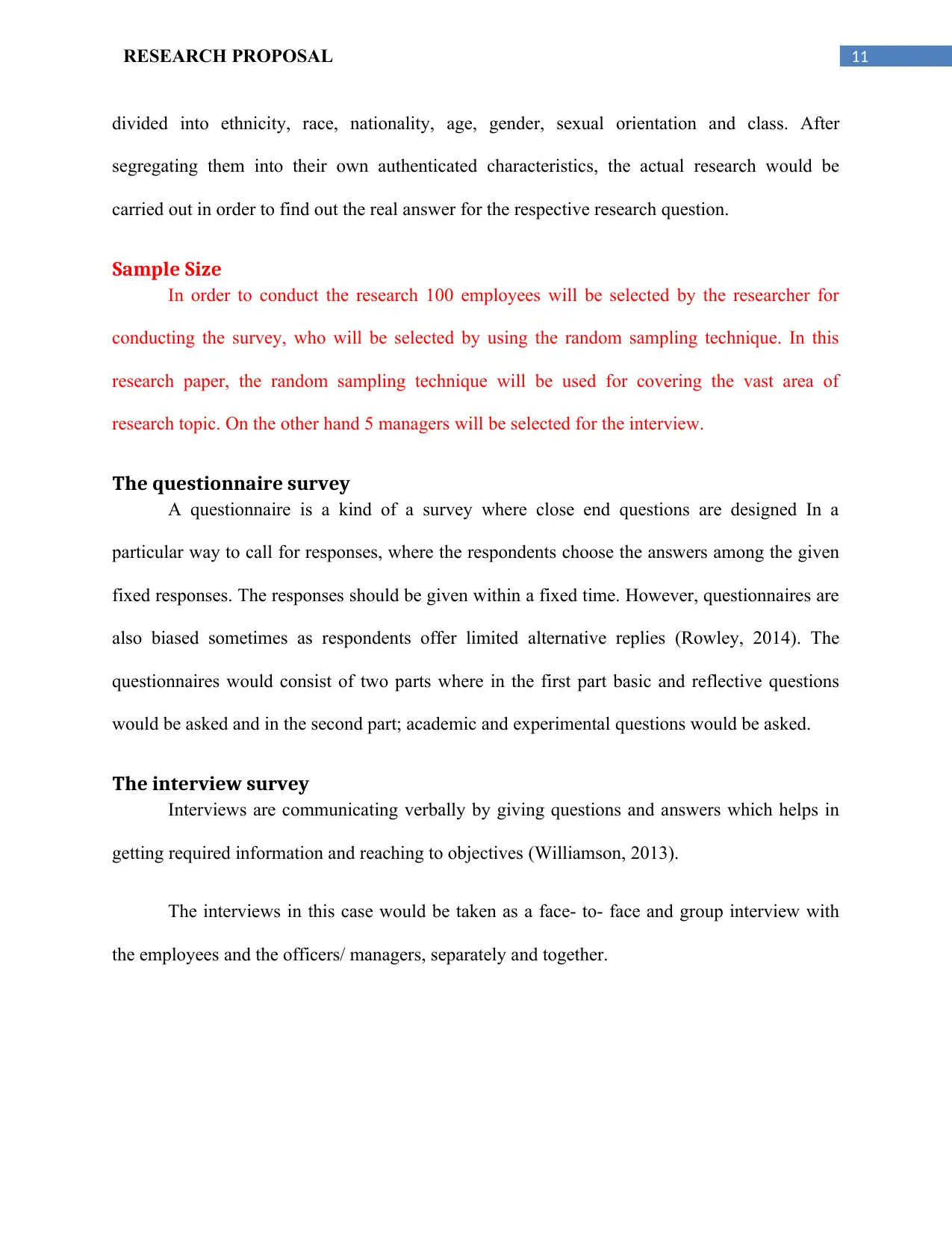
11RESEARCH PROPOSAL
divided into ethnicity, race, nationality, age, gender, sexual orientation and class. After
segregating them into their own authenticated characteristics, the actual research would be
carried out in order to find out the real answer for the respective research question.
Sample Size
In order to conduct the research 100 employees will be selected by the researcher for
conducting the survey, who will be selected by using the random sampling technique. In this
research paper, the random sampling technique will be used for covering the vast area of
research topic. On the other hand 5 managers will be selected for the interview.
The questionnaire survey
A questionnaire is a kind of a survey where close end questions are designed In a
particular way to call for responses, where the respondents choose the answers among the given
fixed responses. The responses should be given within a fixed time. However, questionnaires are
also biased sometimes as respondents offer limited alternative replies (Rowley, 2014). The
questionnaires would consist of two parts where in the first part basic and reflective questions
would be asked and in the second part; academic and experimental questions would be asked.
The interview survey
Interviews are communicating verbally by giving questions and answers which helps in
getting required information and reaching to objectives (Williamson, 2013).
The interviews in this case would be taken as a face- to- face and group interview with
the employees and the officers/ managers, separately and together.
divided into ethnicity, race, nationality, age, gender, sexual orientation and class. After
segregating them into their own authenticated characteristics, the actual research would be
carried out in order to find out the real answer for the respective research question.
Sample Size
In order to conduct the research 100 employees will be selected by the researcher for
conducting the survey, who will be selected by using the random sampling technique. In this
research paper, the random sampling technique will be used for covering the vast area of
research topic. On the other hand 5 managers will be selected for the interview.
The questionnaire survey
A questionnaire is a kind of a survey where close end questions are designed In a
particular way to call for responses, where the respondents choose the answers among the given
fixed responses. The responses should be given within a fixed time. However, questionnaires are
also biased sometimes as respondents offer limited alternative replies (Rowley, 2014). The
questionnaires would consist of two parts where in the first part basic and reflective questions
would be asked and in the second part; academic and experimental questions would be asked.
The interview survey
Interviews are communicating verbally by giving questions and answers which helps in
getting required information and reaching to objectives (Williamson, 2013).
The interviews in this case would be taken as a face- to- face and group interview with
the employees and the officers/ managers, separately and together.
⊘ This is a preview!⊘
Do you want full access?
Subscribe today to unlock all pages.

Trusted by 1+ million students worldwide
1 out of 15
Related Documents
Your All-in-One AI-Powered Toolkit for Academic Success.
+13062052269
info@desklib.com
Available 24*7 on WhatsApp / Email
![[object Object]](/_next/static/media/star-bottom.7253800d.svg)
Unlock your academic potential
Copyright © 2020–2025 A2Z Services. All Rights Reserved. Developed and managed by ZUCOL.





